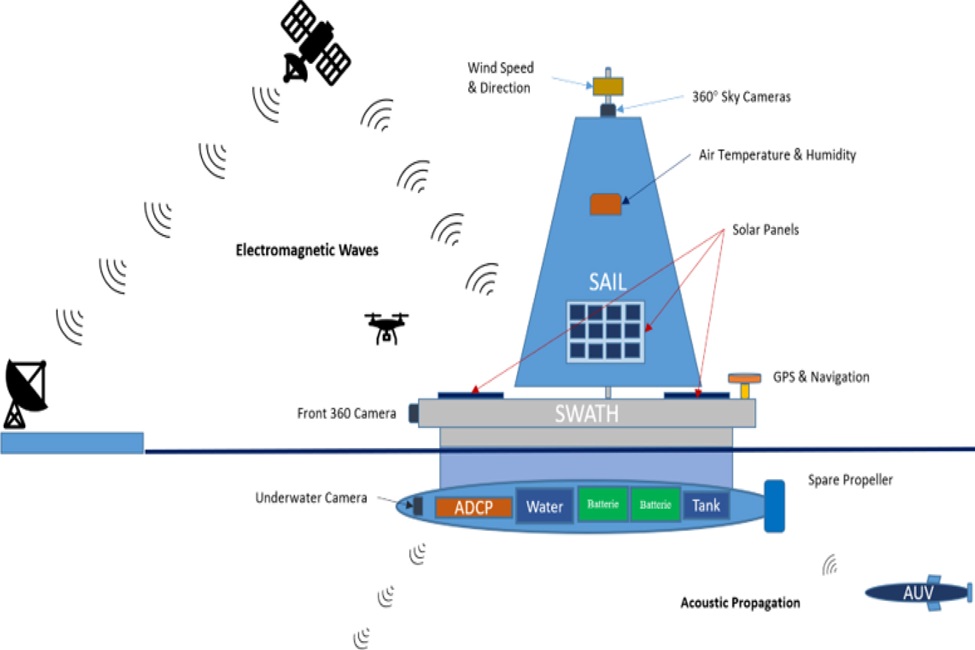FAU Engineers Design New Autonomous System to Monitor Arctic Ice Melt

The rapid melting and thinning of the Arctic ice have sparked serious concerns in the scientific community. In addition, sea ice thickness also has decreased, which makes ice cover more vulnerable to warming air and ocean temperature.
Understanding the ecological role of sea ice in the Arctic is crucial, particularly because the extent of sea ice in the region has been decreasing at an unprecedented rate. What would happen to the Arctic marine ecosystem if the sea ice melted even faster? To answer these questions, a long-term monitoring and data collection system is necessary in the harsh Arctic environment.
However, direct observation is challenging as satellite sensors have a coarse spatial resolution and cannot detect the fine fractal structure of the ice. Deploying human-crewed ships to the area also is difficult due to extreme weather conditions and obstacles posed by floating broken ice. Moreover, traditional ocean observation methods offer limited temporal and spatial coverage, while drones and autonomous underwater vehicles (AUVs) are hindered by energy constraints that restrict their research potential.
To overcome these challenges, researchers from the College of Engineering and Computer Science at Florida Atlantic University have proposed a design of an alternative, autonomous observational method, which holds promise for improving the autonomy of marine vehicles, aiding in maritime missions, and gaining a deeper understanding of how melting Arctic sea ice affects marine ecosystems.
Their conceptual design features a small waterplane area twin hull (SWATH) vessel that acts as a docking and charging station for AUVs and unmanned aerial vehicles (UAVs). The SWATH ship is engineered for exceptional stability, allowing it to navigate through melting ice and operate in a wide range of sea conditions. It is designed to be self-sufficient, utilizing automated sailing, solar panels and an underwater turbine positioned between its twin hulls to generate and store energy, ensuring continuous mission support even when sailing against ocean currents.
Unlike prior platforms, the system designed by the FAU researchers will use advanced technology to monitor the Arctic Ocean from the air, water surface and underwater. The new unmanned surface vehicle (USV) design is specifically tailored for the project to ensure stability in Arctic conditions and handle high wind speeds. The observation platform system’s main objective is to investigate the melting sea ice area. Wind energy will be harnessed to facilitate sailing in the Arctic water, while an underwater turbine will generate sufficient energy to sustain the system’s operations.
Results of the study, published in the journal Applied Ocean Research, show that using the motion of a wind-driven sailboat to generate power from the turbine beneath the SWATH is a feasible way to support long-term Arctic Ocean monitoring missions. The design integrates with the environment it monitors, offering new data on Arctic Sea ice melt beyond what satellites and manned ships can provide.
“Our proposed autonomous observation platform system offers a comprehensive approach to studying the Arctic environment and monitoring the impact of melting sea ice,” said Tsung-Chow Su, Sc.D., senior author and a professor in FAU’s Department of Ocean and Mechanical Engineering. “Its design and capabilities make it well-suited to overcome the challenges of the Arctic’s unique conditions. By providing a self-sustaining platform for continuous data collection, this design supports scientific research, environmental protection and resource management, laying the foundation for year-round monitoring of the Arctic.”
The FAU-designed vessel is essential for marine data collection, integrating UAVs and AUVs for real-time monitoring, resource exploration and research. The UAVs use high-resolution cameras and sensors for mapping and navigation, while AUVs gather underwater data. The DJI Dock 2 system enables UAVs to autonomously land, recharge and redeploy, while an advanced underwater docking system allows AUVs to refuel and transfer data, extending their range. Survey instruments in the underwater hulls collect mission-specific data, which is processed onboard and transmitted via satellite, enabling long-term, unmanned ocean monitoring.
As a self-sustaining platform, wind energy and marine current energy will be applied in this design to achieve the purpose of long-term monitoring in the Arctic Ocean. A dimensionless formula has been developed to estimate the minimum sail area required for varying sizes of SWATH in combination with a wind-driven power system.
“Our researchers have developed an innovative observation system tailored to the Arctic environment, offering critical data on sea ice melt that satellites and manned vessels are unable to capture. Long-term monitoring is essential, as it provides deeper insights into the lasting impacts of Arctic sea ice loss, which can guide informed policy and management decisions,” said Stella Batalama, Ph.D., dean of the FAU College of Engineering and Computer Science. “Additionally, there remains much to uncover about Arctic phytoplankton and algae, which play a crucial role in the food web and influence ocean-atmosphere interactions. This new system could enhance our scientific understanding of their ecological significance while supporting Alaska’s indigenous communities in adapting to future changes in wildlife and food resources.”
First author of the study is Wenqiang Xu, Ph.D., a doctoral degree graduate of FAU’s Department of Ocean and Mechanical Engineering.


-FAU-






